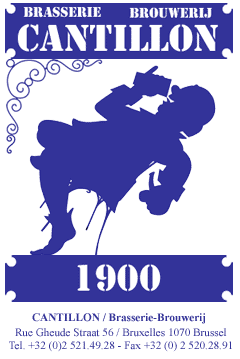Cantillon (brewery)
Brewery in Brussels, Belgium From Wikipedia, the free encyclopedia
Brasserie-Brouwerij Cantillon ("Brewery Cantillon") is a small Belgian traditional family brewery based in Anderlecht, Brussels. Cantillon was founded in 1900 and exclusively brews lambic beers.
 | |
| Industry | Alcoholic beverage |
|---|---|
| Founded | 1900 |
| Founder | Paul Cantillon Marie Troch |
| Headquarters | , Belgium |
| Products | Beer |
| Owner | Jean-Pierre van Roy |
| Website | www |
Overview
The brewery was founded in 1900 by Paul Cantillon, whose father was also a brewer, and his wife, Marie Troch.[1] As of 2011[update], the owner is Jean-Pierre van Roy, the fourth-generation brewer at Cantillon.[2] Since launch, the only major change has been a shift to organic ingredients in 1999.[3] Cantillon was one of more than one hundred operating breweries in Brussels when founded, and was the only one to remain operational through the 2000s.[1][4] In 2014, van Roy announced that the brewery would be acquiring more maturation space, effectively doubling production by 2016–17.[5]
Cantillon produces 400,000 bottles of beer a year.[6]
Beers
Summarize
Perspective

In the traditional lambic style, beers, with a mash bill of 2/3 malted barley and 1/3 unmalted wheat,[1] are spontaneously fermented in open topped attic mounted vats called coolships, aged in oak or chestnut, blended (from different batches and ages), bottled, and then bottle conditioned for a year. Half of the brewery's production is gueuze; once a year a batch of kriek is made.[3] For fruit-flavored beers, empty casks are filled with various fruits and macerated for three months to dissolve the fruits; young lambic is added to supply sugar for fermentation.
- Blåbær - bilberry (made every year for a bottle shop in Denmark)
- Cuvée Saint Gilloise - This is not a traditional gueuze, in that it is made from only two-year-old lambic, not from a blend of old and young beers. It is also dry-hopped in the cask for three weeks with fresh Styrian Golding hops. Re-fermentation in the bottle is achieved with the addition of a small amount of candy sugar.
- Fou' Foune - apricot[3]
- Grand Cru Bruocsella - unblended lambic aged for three years, and refermented with liqueur d'expedition[3]
- Gueuze[3]
- Iris - 100% pale barley malt beer with half fresh hops aged for two years and then dry-hopped[3] with Hallertau hops[1][3]
- Kriek - lambic made with cherries[3]
- Lou Pepe Gueuze - blended from beers of the same age, thus not a strictly authentic gueuze[3]
- Lou Pepe Kriek - with more fruit (cherries)[3]
- Lou Pepe Framboise - with more fruit (raspberries)[3]
- Magic Lambic - 80% Lou Pepe Framboise and 20% blueberry lambic with vanilla[7]
- Mamouche - elderflower
- Nath - brewed with rhubarb
- Rosé de Gambrinus - framboise[3]
- Saint Lamvinus - Merlot and Cabernet Franc grapes[3]
- Soleil de Minuit - cloudberry (made in 1999 and in 2013)
- Vigneronne - Muscat grapes[3]
Gueuze Museum

The brewery also houses the Gueuze Museum.[8] Patricia Schultz listed the brewery and its museum in 1,000 Places to See Before You Die.[9]
References
External links
Wikiwand - on
Seamless Wikipedia browsing. On steroids.
